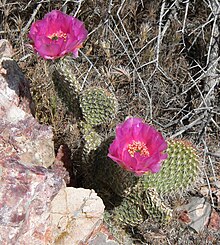
Summary
Opuntia polyacantha is a common species of cactus known by the common names plains pricklypear,[3][4] starvation pricklypear,.[5] and hairspine cactus,[3] panhandle pricklypear.[2] It is native to North America, where it is widespread in Western Canada, the Great Plains, the central and Western United States, and Chihuahua in northern Mexico.[2][5] In 2018, a disjunct population was discovered in the Thousand Islands region of Ontario, Canada.[6][7][1]
| Opuntia polyacantha | |
|---|---|

| |

| |
| Scientific classification | |
| Kingdom: | Plantae |
| Clade: | Tracheophytes |
| Clade: | Angiosperms |
| Clade: | Eudicots |
| Order: | Caryophyllales |
| Family: | Cactaceae |
| Genus: | Opuntia |
| Species: | O. polyacantha
|
| Binomial name | |
| Opuntia polyacantha | |
Habitat edit
This cactus grows in a wide variety of habitat types, including sagebrush, Ponderosa pine forest, prairie, savanna, shrublands, shrubsteppe, chaparral, pinyon-juniper woodland, and scrub.[3] Individual plants tend to thrive in sandy soil. A new plant can grow from a displaced stem segment.[8]
Description edit
Opuntia polyacantha grows up to 10–30 centimetres (4–12 in) tall. It forms low mats of pads which may be 2–3 m (6+1⁄2–9+7⁄8 ft) wide.[3] Its succulent green pads are oval or circular and reach 27 by 18 cm (10+5⁄8 by 7+1⁄8 in) wide. Its areoles are tipped with woolly brown fibers and glochids. Many of the areoles have spines which are quite variable in size and shape. They may be 0.4 to 18.5 cm (1⁄8 to 7+1⁄4 in) in length, stout or thin, straight or curling, and any of a variety of colors.
Flowers grow from spine-covered stem segments which are shaped like semi-flattened pears.[8] The flowers are 2.5 to 4 cm (1 to 1+5⁄8 in) long and may be yellow, magenta,[5] or red in color (tending to turn pink or orange with age).[8] The fruit is cylindrical, brownish, dry and spiny.[5] The cactus reproduces by seed, by layering, and by resprouting from detached segments.[3] In its natural range it survives throughout an immense range of temperatures, ranging from −46 °C (−50 °F) in the Yukon Territory, Canada,[9] to well above 38 °C (100 °F) in places like Chihuahua, Mexico.
There are many expressions of O. polyacantha and variation is common. Multiple varieties have been proposed. Some are accepted by modern authorities and some require further study.[10]
Uses edit
Native Americans used it as a medicinal plant, with different parts treating various symptoms.[11]
This pricklypear provides food for many types of animals. It provides over half the winter food for the black-tailed prairie dog in one area. Pronghorn antelope eat it, especially after the spines are burned off in wildfires. Ranchers intentionally burn stands of the plant to make it palatable for livestock when little other food is available. It will also grow in waste areas where good forage will not take hold. In fact, an abundance of the cactus indicates land that is poor in quality.[3]
Several insects attack the cactus, including the cactus moth Melitara dentata, the blue cactus borer Olycella subumbrella, and the cactus bug Chelinidea vittiger.[3]
O. polyacantha provided the Lewis and Clark Expedition with opportunity for admiration and more often complaint about the plant.[12]
With the skin and seeds removed, the fruit can be eaten raw or made into candy.[13]
[2][6] edit
- ^ Heil, K., Terry, M. & Corral-Díaz, R. 2017. Opuntia polyacantha (amended version of 2013 assessment). The IUCN Red List of Threatened Species 2017: e.T151747A121565302. https://dx.doi.org/10.2305/IUCN.UK.2017-3.RLTS.T151747A121565302.en. Downloaded on 16 September 2021.
- ^ a b c NatureServe (2024). "Opuntia polyacantha". Arlington, Virginia. Retrieved January 6, 2024.
- ^ a b c d e f g Johnson, K. A. 2000. Opuntia polyacantha. In: Fire Effects Information System, [Online]. U.S. Department of Agriculture, Forest Service, Rocky Mountain Research Station, Fire Sciences Laboratory (Producer). Retrieved May 11, 2011.
- ^ Opuntia polyacantha. USDA Plants Profile. Retrieved May 11, 2011.
- ^ a b c d Opuntia polyacantha. Flora of North America. Retrieved May 11, 2011.
- ^ a b Argus, George W. (1982). Atlas of the rare vascular plants of Ontario. Ottawa: Botany Division, National Museum of Natural Sciences = Division de la botanique, Musée national des sciences naturelles. doi:10.5962/bhl.title.51429. ISBN 0-662-50415-1.
- ^ Stephen, Derek (February 2021). "Plains Pricklypear (Variety Opuntia polyacantha polyacantha)". iNaturalist Canada. Retrieved September 17, 2022.
- ^ a b c Taylor, Ronald J. (1994) [1992]. Sagebrush Country: A Wildflower Sanctuary (rev. ed.). Missoula, MT: Mountain Press Pub. Co. p. 38. ISBN 0-87842-280-3. OCLC 25708726.
- ^ Linn, Alan (September–October 1972). "What Can You Expect from the World's Greatest Misers?". International Wildlife. 2 (5): 36–38.
- ^ "Opuntia polyacantha at Opuntia Web". January 24, 2012.
- ^ University of Michigan - Dearborn: Native American Ethnobotany (Opuntia polyacantha)
- ^ "Prickly Pear | Discovering Lewis & Clark ®". April 19, 2021.
- ^ Niering, William A.; Olmstead, Nancy C. (1985) [1979]. The Audubon Society Field Guide to North American Wildflowers, Eastern Region. Knopf. p. 437. ISBN 0-394-50432-1.
External links edit
- Jepson eFlora (TJM2): Opuntia polyacantha
- Species account and photographs from Lady Bird Johnson Wildflower Center Native Plant Information Network (NPIN)
- Opuntia polyacantha — UC CalPhotos Gallery
- Opuntia polyacantha photo gallery at Opuntia Web




